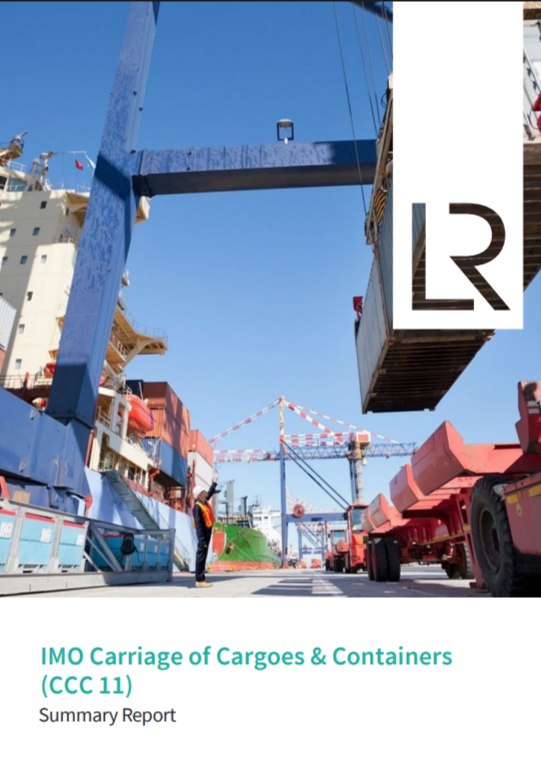TRAINING TOPIC: IMO CCC 11 AND ALTERNATIVE FUELS
This training program, compiled by Lloyd’s Register based on the latest conclusions from IMO/CCC 11, is designed for both seafarers and shore-based staff (QHSE/DPA, technical, newbuilding/conversion, and operations) to safely and compliantly manage the transition to alternative fuels (NH₃, H₂, alcohols, LPG/ethane, low-flashpoint oil, fuel cells, on-board CCS).
Key Learning Objectives
- Understand the legal timeline and new/pending standards for alternative fuels to plan your fleet’s strategy.
- Grasp the core safety and technical requirements for using Hydrogen and Ammonia as fuel, along with updates for methyl/ethyl alcohol, LPG/ethane, and low-flashpoint oil fuels.
- Establish procedures for operations, bunkering, gas detection, ventilation, Emergency Shut-Down (ESD), emergency response, maintenance, and related SMS/ISM documentation.
- Stay updated on mandatory reporting for container loss, CSM/lashing software, and changes to IMDG/IMSBC Codes to ensure synchronized cargo safety during the fuel transition.
- Regulatory Landscape & Key Milestones (2025–2029)
-
Hydrogen (H₂) Fuel – Interim Guidelines: finalized at CCC 11, with approval expected at MSC 111 (May 2026). This is a “goal-based” approach with new requirements for arrangement, materials, control/monitoring, and analysis of gas dispersion, radiation, and explosion to determine mitigation measures.
- Ammonia (NH₃) as Fuel: Interim Guidelines are complete, also pending approval at MSC 111. This supports the IGC Code amendment (MSC.566(109)) entering into force on July 1, 2026. New requirements include an Ammonia Release Mitigation System (ARMS), double-walled/ducted piping, and the non-applicability of the IGC Code’s “safe haven” concept for NH₃ fuel. CFD analysis is required for fuel preparation room ventilation.
- MeOH/EtOH – MSC.1/Circ.1621 Amendment: work has begun, with completion expected in 2027 and incorporation into the IGF Code effective in 2028. IACS UI GF21 requires a minimum free gas volume of 50% of the largest compartment’s gross volume when using CO₂ for fire-fighting in the machinery/fuel prep spaces of methanol/ethanol-fueled ships. This applies to newbuildings from January 1, 2026.
- IACS UI GF22 (IGF 9.6.1) for gas fuel vent masts in a gas-safe area applies to newbuildings from July 1, 2026.
- Comprehensive IGC Code Amendment: The planned entry into force has been delayed to July 1, 2028. New requirements include full-penetration welds, emergency fire pumps, CFD-based ventilation/gas detection outside cargo areas, and automated/centralized monitoring based on risk assessment.
- Carriage of Liquid Hydrogen (LH₂): Part D will be added to the IGC Code for vacuum-insulated membrane tanks, pending approval at MSC 111.
- IMDG Amendment 43-26: Voluntary use begins January 1, 2027, and becomes mandatory on January 1, 2028. It includes new entries (UN 3563 for lithium metal batteries in CTU, UN 3564 for sodium-ion batteries in CTU), new Special Provisions (SP410–413), FRP service equipment for portable tanks, and clarifications for Class 7 segregation.
- IMSBC Amendment 09-27: Voluntary use starts January 1, 2028, and becomes mandatory on January 1, 2029. It adds new bulk schedules, such as PFAS-contaminated soil, U-IBA, and kaolinite.
- Loss of Containers – SOLAS V/31: Mandatory reporting begins January 1, 2026. CCC will issue a circular with guidance on reporting data and handling “double reporting”.
-
CSM & Lashing Software: MSC.1/Circ.1353/Rev.2 is being revised. Standards for lashing software performance are being developed (per IACS UR C6), with completion expected around 2026–2027. Mandatory requirements for containerships may be considered in subsequent CCC/MSC meetings.
- Training Structure (8 Modules, 1.5 Days)
M0. Kick-off & Measurement
- 15-question pre-test (awareness of IGF/IGC, H₂/NH₃/MeOH, IMDG/IMSBC, container loss reporting).
- Objectives, fleet scope, 2025–2029 roadmap, post-training evaluation expectations.
M1. Regulatory Framework & Transition Roadmap
- IGF/IGC/IMDG/IMSBC: “what has been completed, what is pending, when it becomes applicable,” and impacts on newbuilding/retrofit, procurement, SMS.
- Milestone map: Jan 2026 (CO₂/MeOH, SOLAS V/31), Jul 2026 (NH₃ fuel via related IGC), 2027–2028 (IMDG 43-26, revised MeOH guidelines into IGF), Jul 2028 (new IGC), 2028–2029 (IMSBC 09-27).
M2. Hydrogen as Fuel (H₂/LH₂ vessels)
- Design principles: H₂/LH₂ tank layout, safety philosophy; dispersion/radiation/explosion analysis for decision-making; materials; inerting; monitoring–control; testing; operations.
- Ventilation & gas detection based on analysis (CFD recommended) for related compartments; functional requirements for bunkering and piping.
- Membrane LH₂ under vacuum: vacuum management requirements and emergency response. (Applies to LH₂ carriage; referenced for fuel tank designs using similar technology).
M3. Ammonia as Fuel (on gas carriers)
- Fuel piping: apply IGC 16.4 outside cargo area; distinct color coding for NH₃ piping.
- NH₃ gas detection: fixed systems; setpoints not yet defined (not aligned with MSC.1/Circ.1687).
- Ventilation: CFD required to verify inlet/outlet location and capacity for fuel preparation rooms (per IGC 12.1.8).
- ARMS: mandatory emergency NH₃ release collection/neutralization/venting system (open to new technologies, parameters not finalized).
- NH₃-consuming machinery spaces must be gas-safe, with double-walled/ducted piping and continuously gastight outer shell.
- Note: “Safe haven” under IGC 17.5.5 does not apply to NH₃ fuel concept.
M4. MeOH/EtOH & Low-flashpoint Oil Fuels, LPG/Ethane, Fuel Cell, CCS
- MeOH/EtOH: roadmap update 2027–2028; IACS UI GF21 requires CO₂ firefighting free gas volume ≥50% of the largest compartment.
- Low-flashpoint oil fuels: discussion to continue at CCC 12 → target completion at CCC 13 (2027).
- LPG/ethane as fuel: CFD required for ventilation and gas detection arrangements outside cargo area (per IGC amendments 2028).
- Fuel cell & on-board CCS: included in IGF Work Plan (guidelines under development).
M5. Operational Procedures: Bunkering – PTW – ESD – System Testing
- H₂/NH₃ bunkering: site prep, ignition source control, tightness check, gas monitoring, communication, ESD functional testing, ventilation verification, temperature/pressure control, anti-freezing measures (LH₂).
- PTW: hot/cold work permits, ESD interlock check, isolation locks, detector test.
- ARMS/NH₃: emergency drills for release collection–neutralization–ventilation.
M6. Emergency & Medical Response – Specialized PPE
- Scenarios: H₂/NH₃ leakage, jet fire, over-pressure, LH₂ insulation vacuum loss, ventilation fan failure, ESD chain activation.
- PPE for NH₃: corrosion-resistant suits, compatible masks/SCBA, emergency eyewash/shower stations.
- CO₂ for MeOH/EtOH ships: volume sizing per UI GF21, validated via drills/periodic testing.
M7. Dangerous Goods – Cargo Securing – Container Loss Reporting
- IMDG 43-26: introduce new entries (esp. Li metal/Sodium-ion batteries in CTU), SP 410–413, FRP equipment requirements for portable tanks, standardized segregation for Class 7 by ship type.
- IMSBC 09-27: identify new schedules (PFAS soil, U-IBA, etc.), review TML and Group A/B/C classification.
- CSM & lashing software: prepare calculation data, train users (per UR C6), update CSM with annex.
- SOLAS V/31: procedure for lost/missing container reporting (content, channels), coordination for “double reporting.”
M8. Company Implementation (90–180–360 days)
90 days
-
- Identify ships/routes/payloads feasible for NH₃/H₂ transition; initiate HAZID/HAZOP per IGF/IGC; prepare NH₃ piping color-coding diagram; assess CO₂ ≥50% capacity for MeOH/EtOH vessels.
- Review detectors & ventilation; plan CFD for fuel-related spaces.
- Develop role-based training: Master/2/O/ETO/C/E/2/E, bunkering team, HSE office, DPA, newbuilding.
180 days
-
- Update SMS/ISM: SOPs for H₂/NH₃ bunkering, ARMS, PTW, ESD tests; CSM + lashing software annex; SOLAS V/31 procedures.
- Procure NH₃ PPE, emergency showers, signage; set Maintenance Plan for detectors/ESD/fans.
- Conduct quarterly drills: NH₃ leakage, LH₂ vacuum loss, container loss reporting.
360 days
-
- Complete CFD and design/retrofit approvals; prepare for newbuilding/retrofits (if any).
- Integrated testing: FAT/SAT of fuel systems, ESD, gas detection, ventilation; multi-scenario drills.
- Align IMDG/IMSBC (applicable editions) with DG manuals and training matrix.
3) Competence by Role & Training Matrix (suggested)
- Deck (C/O, 2/O, Bosun): hazard identification for H₂/NH₃, zoning, gas testing, ESD operations, bunkering line-up checks, SOLAS V/31 reporting, CSM & lashing software (for containerships).
- Engine (C/E, 2/E, ETO): fuel systems (double-walled/ducted), monitoring–control, detectors, fans–inerting, ARMS, CO₂ sizing per UI GF21, maintenance & periodic testing.
- Safety/QHSE/DPA: SMS updates, risk assessments, compliance recordkeeping, Management of Change (MOC), coordination with Flag/Class.
- Technical/Newbuilding Office: CFD studies, material/equipment selection, ESD/PLC interlocks, tank–piping layout, approval preparations.
4) Sample Operational Checklists (to be embedded in SMS)
NH₃/H₂ Bunkering – Pre-job briefing
- Area preparation, signage, ignition source control, space limitation; detectors & fans ready and tested; ESD chain ON/OFF functional test; PTW approved; PPE team complete (NH₃ suit, SCBA); line-up & purge; communication established; emergency release plan (ARMS/ventilation).
Periodic Testing
- Detectors: calibration;
- Ventilation: flow/pressure checks;
- ESD: pump/valve interlock test;
- CO₂: confirm free gas volume ≥50% (MeOH/EtOH).
Typical Scenarios & Response
- NH₃ leak: isolate, activate ARMS, increase ventilation per CFD scenario, control access, medical–decontamination response.
- LH₂ vacuum loss: unload, isolate, shift to safe mode, monitor temperature–pressure.
5) Post-training Evaluation & Competence Assurance
- Post-test, tabletop HAZID for bunkering, multi-scenario drills; passing criteria: ≥80% knowledge, 100% compliance with critical safety steps.
- Competence follow-up via OJT logbook (3–6 months).
6) Key References
This module summarizes and adapts content from CCC 11 – Summary Report (Lloyd’s Register, 09/2025), including: H₂ & NH₃ interim guidelines (to MSC 111), IMDG 43-26 (2027/2028), IMSBC 09-27 (2028/2029), IGC amendments (2028), IACS UI GF21/GF22 (2026), LH₂ membrane vacuum Part D, CSM/lashing software, and SOLAS V/31 container loss reporting (effective 01/01/2026).
Below is the Detailed Training Matrix by role (as per CCC 11 report and 2025–2029 alternative fuel transition roadmap), divided into: Deck, Engine, ETO, QHSE/DPA, Technical/Newbuilding Office, and Master for training implementation.
Detailed Training Matrix For Seafarers & Shore-Based Staff
|
Role |
Key Training Topics | Relevant Standards/Regulations | Training Format |
Frequency |
|
Master |
Overview of IMO/CCC 2025–2029 roadmap; SOLAS V/31 reporting; Decision-making for safe bunkering & emergencies; SMS, PTW, MOC management. | IGF, IGC (2026/2028), SOLAS V/31 | Classroom + Tabletop Exercise + Live Drill | Annually + as IMO Circulars are issued |
|
Deck Officer |
H₂/NH₃ bunkering procedures; Gas testing, zoning, ESD; CSM & lashing software; IMDG/IMSBC amendments; Container loss reporting. | IGF, IGC, IMDG 43-26, IMSBC 09-27, UR C6 | Onboard Drill + CBT | Every 6 months |
|
Chief Engineer & 2nd Engineer |
H₂/NH₃ fuel systems (double-walled/ducted, ARMS); Ventilation/Detector maintenance; ESD interlocks; CO₂ calculation per UI GF21; Fuel cells, CCS updates. | IGF, IGC, UI GF21/GF22 | Technical Workshop + Simulator | Annually |
|
QHSE/DPA |
Updating SMS, ISM, PTW; SOLAS V/31 SOP; Risk assessment (HAZID/HAZOP); MOC; Coordinating with Flag/Class. | ISM, SOLAS, IGF/IGC | Workshop + Tabletop Exercise | Annually |
|
Newbuilding/Technical Office |
CFD studies; Piping/ventilation design; Material selection; CO₂ sizing for MeOH/EtOH; CSM/lashing software updates. | IGF, IGC, IACS UR, Class Rules | Seminar + Project-based Training | Per project |
|
All Seafarers |
General introduction to alternative fuels; PPE, emergency evacuation, first aid for NH₃/LH₂ leaks; Drills for fire, toxic release, and ESD. | IGF, ISM, STCW | Induction + Onboard Drill | Quarterly |
How to Use the Matrix
- Integrate into your company’s Training Matrix, connecting it to STCW mandatory and company-specific requirements.
- Track competency with a job-specific logbook (OJT logbook).
- Update cycles should be every 6–12 months or as new circulars are issued by the IMO, Flag State, or Class.
- Expected outcomes include achieving a ≥80% on post-tests and 100% correct performance on critical safety procedures like ESD, detector tests, and SOLAS reporting.








